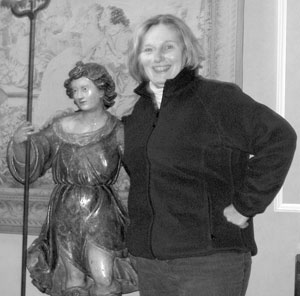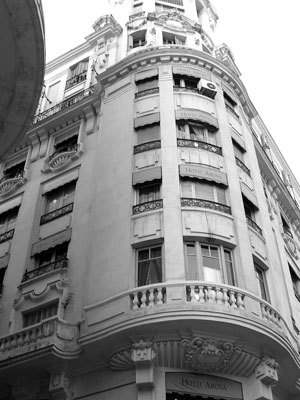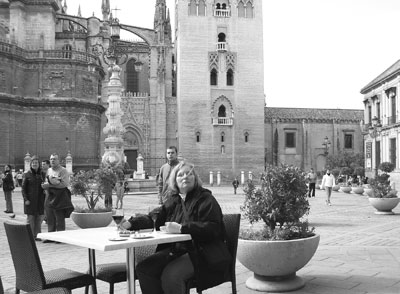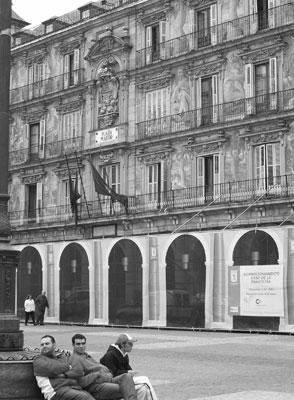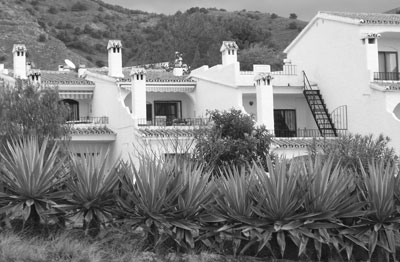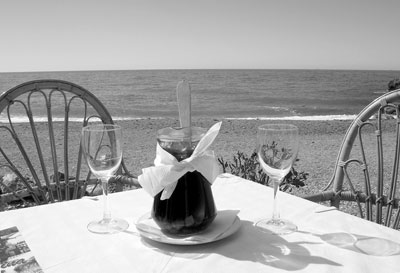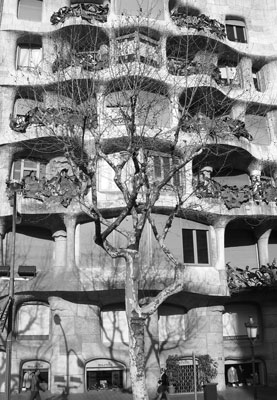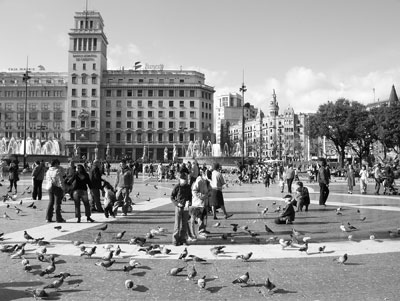Exploring España
by Marvin Herman & Judy Licata, Delavan, WI
My wife, Judy, and I, both in our late 60s, have taken many escorted tours and have also toured independently, but neither of us had been to Spain (although we had visited almost every other country in Europe). So we decided on a trip to Spain, in February-March ’06, not only to experience a new country together but to challenge ourselves, as seniors, to an independent travel experience where the journey would be as important as the destination.
Making arrangements
We set out on our 22-day visit to Spain by booking the flight and some hotels using the Internet. We flew KLM from Chicago to Madrid, with return to Chicago from Barcelona. Each flight had a short layover in Amsterdam.
As part of that airline booking, we also included two nights in Madrid at the Best Western Arosa, in a corner room overlooking the Gran Via, and two nights in Barcelona at the Citadines Apart’hotel Ramblas. The cost of the flights and the hotel stays totaled $1,641. We now believe it was a mistake to book the hotels together with the air, as we could have gotten better prices booking the hotels separately.
The Arosa (phone 34 91 5321600, www.bestwestern.com) is very well located. It has the smallest elevator I have ever seen in a hotel, and the rooms were very small as well. A cold breakfast was offered which, at E8 ($10), was overpriced. There were plenty of restaurants in the area that served a nice breakfast for half that.
The Arosa refused to give us credit for the Best Western Golden Club since we did not book directly with them but through Expedia.com. Also, they didn’t have coffee in the room or an ice machine, and they wouldn’t mail a postcard for us.
Madrid sights
In Madrid, we visited the Museo Arqueológico (Judy is an ancient-history buff) and the Museo del Prado.
We spent hours walking through this large, busy European city with its many beautiful old plazas. When we got lost in Madrid (and, for that matter, anywhere in Spain), we stopped and asked people on the street and they were very helpful. Neither of us speaks fluent Spanish, but we had listened to some CDs before our trip to supplement our high school courses.
For meals, we frequented several tapas bars which served drinks and small portions of many Spanish dishes. We learned that almost everything closes down for siesta at 4 p.m. and opens again at 6:30 or 7. We could never get the hang of eating dinner at 9 or 10 as the Spaniards do, but we tried it on several occasions. We recommend “Rick Steves’ Spain 2006” for tips on the tapas scene.
On to Seville
From Madrid, we took an AVE train to Seville; it was one of two rail journeys we booked online before we left home (www.raileurope.com). We were scheduled to depart from the Atocha train station. It was not far from our hotel, so we decided to walk, dragging our luggage. While not far, it was, we discovered, an uphill journey and we really should have taken a taxi. We also should have had breakfast before we got to the station, since the prices at the station were exorbitant.
The AVE was speedy and offered a beautiful ride through the midlands of Spain.
In Seville we stayed at Hotel Alcántara (phone +34 954 50 05 95, www.hotelalcantara.net), where we had a back room which can only be described as tiny. However, the window opened onto a partial view of the cathedral and the Giralda bell tower and it was, once again, a very nicely located hotel.
The Alcántara had a very helpful staff who went that extra step to ensure that we had a memorable experience in the city and helped us with other travel plans. We had reserved our room there in advance on the Internet (E60 per night, cash).
Right next to our hotel, Casa de las Memoria presents a performance of flamenco music and dancing each night (E12 per person, as opposed to the E35 charge at one of the tourist flamenco clubs). The performance we attended was excellent and very professional.
Afterward, we stopped for tapas at a bar called Doña Lina, where we had paella, squid brochette, fried calamari and bacon tapas. I tried the local Manzanilla wine, which tasted a bit like pinot grigio.
The next day, we walked the twisting old streets of Barrio Santa Cruz and noted, with interest, the large groups of tourists following their tour leaders through the streets. We were glad that we were not among them.
As the skies opened, providing the proverbial “rain in Spain,” we walked across Avenida de la Constitución toward the Centro, crowded with local shoppers and families strolling the streets and looking in windows. The rain soon abated and we joined the crowd for the paseo experience. After an hour of mixing with the locals, we stopped for tapas, getting some sweets para llevar (to go).
We found the people of Seville to be very proud of their city, and rightly so, since it is full of old Roman sites in addition to its beautiful cathedral and tower.
Andalusia’s Arcos
The next day we toured the Alcázar, which was free to us since we are over 65. After that, we walked to a coin-and-stamp market and stopped for a bottle of wine and a plate of olives (E12) in the Giralda Plaza.
Back at our hotel, we placed a call to Fabiola Domingues at Cortijo la Hoya in Tarifa to book a self-catering casita on the south coast off the Strait of Gibraltar. We had come upon her establishment on the Internet (www.cortijolahoya.com).
The Alcántara staff were helpful in calling Fabiola on her cell phone for us so we could tell her when we would arrive. Arrangements were made to meet her so she could guide us to her house, which is not easily accessed, when we reached Tarifa.
The next day we rented a car from Auto Europe (www.autoeurope.com) for $408 for the week. We picked it up at the Santa Justa train station in Seville.
After a failed attempt to find Itálica, a ruin located just north of Seville, we drove to Jerez de la Frontera, known for its bodegas that make the leading sherries of the world, including Sandeman and Harveys Bristol Cream. A popular brand is Tío Pepe, made by Gonzalez Byass in Jerez since 1835. We visited its bodega and made our purchases there, barely beating several tour groups.
Leaving Jerez, we headed for Arcos de la Frontera, our first of what are known as the “white towns of Andalusia,” so called because of the clusters of whitewashed houses set into the hills.
Our original plan was to stay on a farm outside the town, but it was closed for remodeling. We therefore returned to Arcos, where I encountered difficulty negotiating the narrow lanes, a problem compounded by the flitting motor scooters coming at me from everywhere. The sound of these machines was incessant in this town.
Somehow, we found our way to the top of the cliffs leading into the city, where we were able to park. The parking lot was packed. It was run by an old fellow who directed traffic and told us where we stood in terms of being entitled to a parking space. While Judy went to scout a hotel, I became segundo, then primero, then finally got a space. The attendant watched my car (E2) while we went to our hotel to book a room. At the hotel, we purchased a parking pass to stay overnight (E3).
We stayed at El Convento (phone 956 702333, www.webdearcos.com/elconvento), a Rick Steves recommendation, at E54. On the way to the hotel (formerly a convent, of course), we bought ham, sausage, cheese and potato crisps, which we enjoyed on our terrace with a magnificent view overlooking the farms and rolling hills of Arcos. Forgoing fulfillment of our dream of churros and chocolate later in the evening, we fell asleep, exhausted.
The next day, after touring the Old Town of Arcos and its white alleys, we headed for the car park for our trip out of the city.
Tarifa
On our way to Tarifa, we stopped in Vejer, another “white town.” Outside Tarifa, we met Fabiola at Mesón de Sancho, then followed her to Cortijo La Hoya.
To access the road to the casita, we had to pull into a narrow strip of land off the highway and back down a steep road. That accomplished, we traveled several miles over bumpy roads, finally arriving at Fabiola’s large house next to four casitas. They all were empty. All the casitas overlook the Strait of Gibraltar, across which can be seen the lights of Africa.
It was Andalusia Day (Feb. 28) and all the stores were closed, thus we were unable to shop. Fabiola “lent” us a large basket of provisions: ham, eggs, potatoes, sardines, crackers, canned fruit and pasta. We sat for hours under the pergola and watched the freighters and cruise boats. Later I cooked pasta with fresh rosemary picked from the garden, and we played my flamenco CDs during our candlelight dinner, actually dancing with happiness to have arrived at this special place.
The next day we headed to the supermarket to replace the food from Fabiola’s basket and buy our own for the day. When we returned, I tried to access our little road going forward off the highway and almost put the car in a ravine. Luckily, I was able to do a tight turn and get into position to back down the road.
In the morning, we paid Fabiola E120 for the two nights in the casita and headed for Gibraltar.
Gibraltar and Ronda
The streets were clogged with cars and tour buses as we entered Gibraltar, but we found a place to park, took pictures of The Rock, had lunch at Piccadilly Bar (don’t be fooled; it’s run by Spaniards) and headed out along the coast and into the Sierra Nevada Mountains through many kilometers of switchback roads until we reached the town of Ronda, a large “white” town.
We had planned to stay at Alavera de los Baños (E90), but after driving around Ronda, and even stopping at the Tourist Information Center, we were not able to locate it. Finally, we asked a fellow on a bicycle and he told us to follow him, which we did.
We entered the hotel and were shown a small, stuffy room with no view, so we returned to the main area of town and pulled into a parking lot to decide where to stay. It was the lot of the Husa Reina Victoria (phone 95 287 1240, www.husa.es), a very fine hotel with a view of the gorge that we had just scaled in our trusty Renault. We had a choice of a larger room with no view, but we decided to take the view (E74 per night).
To celebrate our choice of hotel, we sat on the nice terrace outside our room and enjoyed olives, cheese, tostados and sweets washed down with the wine we had bought the day before in Tarifa.
After a walk through the Old Town the next day, starting at the cathedral and continuing to the bridge that connects the Old Town to the new section of Ronda, we walked to the Palacio de Mondragón, now a museum tracing the history of the area from 6000 B.C. and including replicas of Moorish burial pits and cave dwellings along with nice gardens.
Later in the day we drove to the Cuevas de la Pileta, an archaeological area of caves with paintings and writings. We joined a tour; there were 20 in our group. We were the only English speakers, but the tour was conducted in several languages, including English. We saw cave structures and paintings said to be 25,000 years old.
Judy and I were about 20 years older than the next-oldest person on the tour, and we were very proud of ourselves for keeping up!
When we got back to the hotel, it was too cold to be on the terrace, so we went out to Casa Mateos, a restaurant on Calle Jerez near the bullring. It is a small place with about eight tables, and we were the only non-Spaniards there.
We had two glasses of red Rioja wine, a plate of pork with pimiento sauce, ham rolls with fried potatoes and bacalao in vinegar and oil (E24).
The Costa del Sol
Ronda was a great place to visit, but it was time to head down the Costa del Sol to Nerja. Our friends had visited 30 years before and we told them we would go check it out. It was gloomy in the Sierras as we passed Málaga and found Nerja.
We parked in town and visited the information center to ask about El Capistrano Villages (phone 0034 95 252 2813, www.elcapistrano.com), the place our friends had stayed. After a walk through town to the tourist-laden Balcony of Europe, where there were the requisite musicians playing Mexican and Ecuadorian music plus, of course, mimes in poses of statues, we found our way to the Villas.
At the reception desk, we met Juan Moreno, who showed us a couple of places for E39 per night (E37, if paying cash). We took a smaller place with a great view of the Mediterranean. (It was not on the beach but up in the hills above Nerja.) Our unit, a self-cater condo, had a bedroom, living room and bath plus a large terrace with a table and lounge chairs. The complex had a clothes washer and a rack for drying laundry out on the terrace.
Our days in Nerja provided a much-needed rest and gave us a chance to get a suntan. We also visited the nearby village of Frigiliana, the least impressive of the “white” towns that we visited. It has a small area devoted to the overflow of tourists from Nerja and that’s about it, plus prices there were astronomical.
The next day we went to Cantarriján Beach off the Cerro Gordo turnoff. After a couple of miles of very steep and twisty road, we hit the big beautiful beach.
We ate at Bolo Marina Restaurante and were served a nice meatball tapa. We ordered sangria and paella for two at our beachside table (E30), and it was delicious and peaceful since we were the only ones there until we were almost finished eating.
After lunch, we took a walk down the beach, part of which is reserved for nude bathers. Then we roared back up the mountainside with beautiful views of the beach and the town of Moro below.
Granada
Soon our peaceful rest in Nerja was over and we woke up early to make the drive to Granada. We descended into fog, which made us glad that we had gotten an early start so as to avoid the hassles of a late car return. However, it was the morning rush hour in Granada and we just made it to the Auto Europe office at the train station on time.
We caught a cab to Hotel Puerto de las Granadas, located on Questa de Gomerez, a small and very well-located hotel with absolutely wonderful personnel — the kind of people who will chase you down the street to tell you about some restaurant they forgot to mention as you stood at reception.
After checking in, we walked to Plaza Nueva, then toward the cathedral and the Royal Chapel. The cathedral is huge, one of the largest in Spain, and the chapel contains the remains of Ferdinand and Isabella plus many artifacts.
In Santa Ana Plaza, we stopped for a sangria and a mozzarella-and-tomato salad before making our way to the Hammam Arabic Baths to make a reservation for later in the afternoon. When we arrived at the baths later, there were a dozen young French girls undressing in the unisex changing room. Judy took charge and made sure I waited for them to finish changing before entering.
We spent about 1½ hours at the baths, which included a 15-minute massage that was quite pleasant and professional. The rest of the time was spent soaking in alternate hot and cold baths, which left us totally relaxed.
After the baths, we spent the rest of the day walking in the Albaicín, the Moorish district, with its narrow and twisting lanes.
Our recommendation for dinner was Bodegas Castañeda (Almireceros 1), where we ordered the plato caliente. In addition to having great food, this is a great place to people-watch, and it’s frequented almost entirely by locals.
On the way back to the hotel, we stopped at Pastelería Le Gracia de Dios (just off the Plaza Nueva at Elvira 5) and secured a small bag of cookies, which we saved to have with coffee in the morning.
The following day was Alhambra day. We had reserved a 2:00 entry time for the Nazrid Palace on the Internet (www.alhambratickets.com) before leaving home (E15.76). It is important to do this because entry is limited.
We rode the tourist bus up the hill to the Alhambra (E1), found the place to pick up the tickets we had reserved and walked down the hill to start our self-tour with handheld receivers that guided us through. We spent about five hours touring the site, including the Generalife Gardens.
The following evening, our train to Barcelona was to leave at 9:25, so the hotel stored our luggage during the day so we could spend the day walking the Alcaicería, the old silk market, and finish walking every bit of the Albaicín. The former was very colorful, with merchants hawking their wares and playing Arabic musical instruments.
In the afternoon, we visited the Bib Rambla, a very active plaza in the Albaicín, and stopped at an outdoor food market, where we bought figs and dried apricots to eat from a paper bag. It was a Saturday and the food markets were very active.
Barcelona
Finally, it was time to collect our luggage and head for the train station for our overnight train ride to Sants station in Barcelona. We settled into our tiny compartment, which also contained our luggage on the two upper bunks. We left the curtain open and squinted through the night to pick out the beautiful mountain views available to us. Finally, we laid back and let the motion of the train rock us to sleep. We woke around 7 the next morning and went down to the dining car for a breakfast of coffee, tostada, juice and marmalade.
After arrival in Barcelona, we took a cab to Apart’hotel Citadines Ramblas (phone 34 93 270 11 11, www.citadines.com), which we had booked before leaving home. It is nicely located toward the upper part of Las Ramblas, the main tourist area of Barcelona.
We noticed that the cab driver insisted on placing our small carry-on bags in the trunk of the cab so he could levy the surcharge for baggage on those and increase the fare. It was E8 for the ride to the hotel.
This hotel comes with absolutely no services. I asked for additional towels so we could have fresh ones for each morning and when we checked out we were charged E7 for the use of those towels.
We had a nice large room in the back that was quieter than those overlooking the Ramblas, yet it came with a sofa that pulled out into a bed. That’s what you get in Barcelona for E130 ($157) per night.
We toured the cathedral and the cloister, which has 13 geese in attendance at all times in memory of Santa Eulalia, the patron saint of Barcelona, who was martyred by the Romans in the fourth century at the age of 13.
Sunday is supposed to be the day that locals gather at noon to dance the sardana behind the cathedral, but on this day the area was taken up by another celebration, with a band and dancers of another kind.
Lunch on the Ramblas set us back E35, but that’s what it costs to sit there and watch the tourists go by. As we walked down to the monument to Columbus, we concluded that Barcelona was the most expensive and spread-out city we had toured in Spain.
We bought day passes (E18) for the Bus Turístic that took us all over the city. One can get out at any of dozens of stops on three lines to see a certain site or neighborhood in greater depth. We got to see many of the famous architectural works by Gaudí, including Sagrada Família and Parc Guëll — very beautiful and colorful — which we walked to from one of the stops. We also went to City Arqueològic Museu (Passeig Santa Madrona 39), which Judy loved.
On our last day in Spain, we strolled down the Ramblas to a bird-and-pet market, with rabbits, mice, hamsters and chickens for sale, then we walked to the wonderful La Boqueria market and bought some salads to eat that night with a bottle of hearty local wine.
While in the market, we came upon a great seafood counter with food that looked so fresh and tasty we couldn’t resist. It was one of our best meals. Judy had monkfish and cod with garlic mayonnaise and avocado. I had fried squid and an order of lamb chops done on the grill.
Thus fortified, we went to a music shop on the Ramblas called Casa Beethoven, where we bought a gift of a musical sardana composition for one of our friends at home.
Back at our hotel, I ordered a 4 a.m. wakeup call for our 6:00 flight home. ¡Hasta la vista, España!


